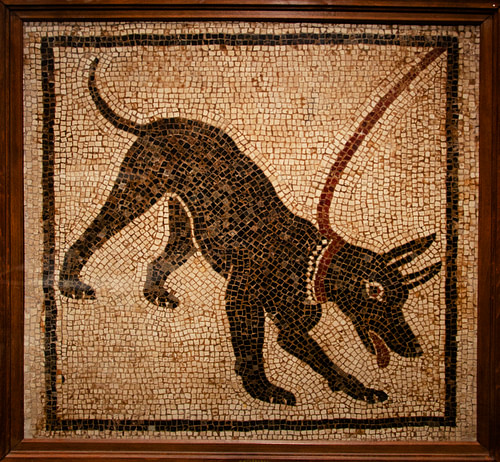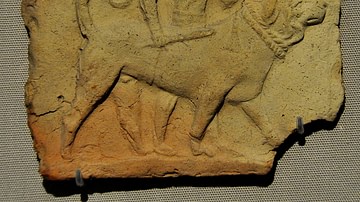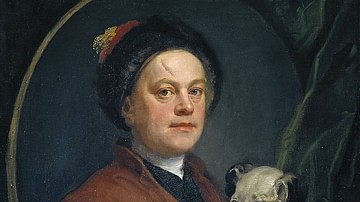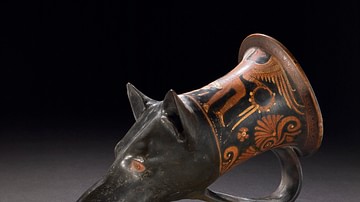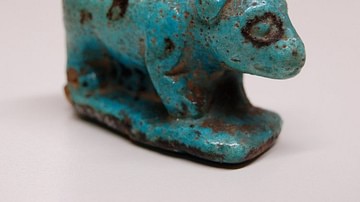The dog collar, so often taken for granted, has a long and illustrious history. Anyone fortunate enough to share their life with a dog in the present day is participating in an ancient tradition every time they place a collar around their dog's neck and take it out for a walk.
The dog collar is a global link between people in the present, no matter their nationality, religion, or political affiliation, which also connects them firmly with the past and each other.

According to the AVMA (American Veterinary Medical Association), 43,346,000 households in the United States own dogs while statistics from Rainwalk Pet Insurance place the number for 2022 much higher at 70 million. The Insurance Information Institute, in their 2017 survey, concluded Americans spent $69.4 billion on their dogs in that year alone, while the recent A Pup Above dog food infographic, drawn from the APPA (American Pet Products Association) 2021-2022 survey, gives an estimate of $1,480.00 in annual expenses for dog owners ($81.00 in "treats" alone), who now, as noted, number close to 70 million in the USA. It is no surprise that dogs are among the most popular and best-loved pets in the present day, but the designation of “man's best friend” is no recent development. Dogs and humans have been walking together since ancient times and the dog collar has been the common denominator in every era.
Oldest Depiction of Leashed Dogs
The basic design of the collar has not changed since the time of ancient Mesopotamia but variations on the collar, specifically ornamentation and style, reflect the values of the various world cultures that kept dogs. These subtle, and sometimes not so subtle, alterations to the central design can be quite telling in the role dogs played and how they were regarded in different time periods and cultures.
The oldest depiction of what seems to be dogs on leashes – suggesting some sort of collar – comes from the region of Shuwaymis in modern-day northeastern Saudi Arabia. In a November 2017 article in Science magazine, author David Grimm describes the work of archaeologist Maria Guagnin of the Max Planck Institute for the Science of Human History in Jena, Germany. Guagnin and her team cataloged over 1,400 rock art panels at Shuwaymis and another region, Jubbah, which include depictions of hunting dogs. At Shuwaymis, one panel shows thirteen dogs and a male hunter; two of the dogs are linked to the hunter by lines which have been interpreted as leashes. This panel is dated to 8,000 years ago.
Mesopotamian Collars
The find should come as no surprise since early development of the dog collar can be traced to the ancient Mesopotamian region and others nearby. The ancient Mesopotamians (probably the Sumerians) most likely invented the collar but, as with the question of where dogs were first domesticated, this topic is still debated. The original Mesopotamian dog collar was a simple cord thrown around the dog's neck which the owner would use to control the animal. In time, this cord was replaced by a collar, probably of cloth or leather, which attached to a leash or long stick.
Dogs were associated with Gula, the Sumerian goddess of healing and health, because it was noted that they healed their wounds through licking them. Dogs were also, however, associated with Inanna/Ishtar, goddess of love, sex, and war, who was often represented as holding her dogs on leashes attached to thick collars. Dogs, therefore, came to symbolize health, vitality, and protection – from both natural and supernatural threats – as exemplified in dog figurines and amulets.
In time, as Mesopotamian civilization became more complex, so did the dog collar; by the time of the fall of the Assyrian Empire in 612 BCE, the collar was quite ornate among the upper-class and, generally, had evolved from a simple rope or cord to a kind of slip-lead and then to a snug-fitting band which was probably pushed over a dog's head to fit around the neck.
The Collar in Persia
Dog collars in ancient Persia are said to have been quite ornate – dogs of the upper class reportedly wore “trappings of gold” and were given fine linen to wear – while collars of the lower class were most likely made of leather or simple cloth. Whichever class one belonged to, dogs were kept for protection, herding, hunting, and companionship. Dogs were so highly valued by the Persians that one's final destination in the afterlife was partly determined by how well – or poorly – one had treated dogs. It is, therefore, not surprising that those who could afford it gave their dogs high-quality collars.
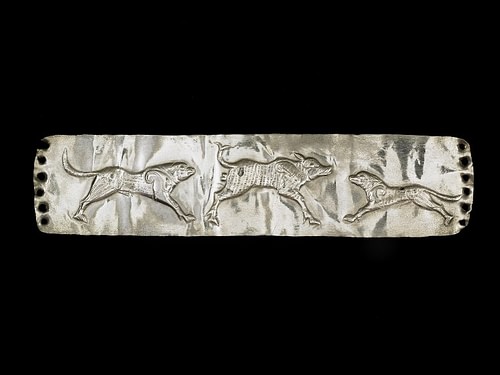
Most depictions of dogs from ancient Persia, however, show dogs without collars (such as on the ceramics found at the ancient city of Susa) and even early art depicting hunting scenes shows uncollared dogs chasing the game. Later Sassanian Art (224-651) gives the impression of the ornate collars of the wealthy, but no surviving documentation provides evidence of lower-class dog collars. Such collars must have existed, however, as people of every social class seem to have valued dogs equally.
Ancient Egyptian Collars
Collars in Egypt followed a similar paradigm of simple-to-complex, but the Egyptians held animals, generally, in higher esteem than most other cultures and collars reflected that value. The early Egyptian collar was also simply a rope but was a recognizable collar by the time of the Old Kingdom (c. 2613-2181 BCE). The collar developed during the Middle Kingdom (2040-1782 BCE) and, by the time of the New Kingdom (c. 1570 - c. 1069 BCE), had become works of art celebrating dogs through intricate design and ornamentation. Dogs were associated with the jackal-god Anubis, guide to the afterlife, and collars began to take on grander designs reflecting dogs' elevated status. Two dog collars from the tomb of the nobleman Maiherpri (from the New Kingdom) are ornamented with brass studs and images of lotus flowers, dogs on the hunt, and one of them even gives the dog's name: Tantanuit. The practice of putting a dog's name on its collar, commonplace today, first appears in ancient Egypt.
Collars in Ancient Greece
Egypt's long-standing association with Greece through trade most likely influenced the Grecian dog collar, but the Greeks needed a collar which would not only control the animal but protect it from predators such as wolves. The ancient Greek invention of the modern-day choke-chain collar and spike collar was inspired by this need. The Greeks also valued the dog, as evidenced by their regular appearance in Greek mythology and Greek literature such as the three-headed dog Cerberus who guarded the gates of Hades and Odysseus' loyal dog Argos, among others. Plato even claimed that the dog is a true philosopher owing to its ability to tell friend from enemy and truth from falsehood without instruction.
Greek collars express this admiration through elaborate ornamentation and bright colors. Evidence of this comes from the Greek drinking cups (rhyta or rhytons, plural and rhyton, singular) and other tableware which are ornamented with images of collared dogs. Few actual dog collars have survived but collars in art and these figurative collars are thought to represent actual collars.
Roman Collars
The Romans inherited the concept of the dog collar from the Etruscans as evidenced by wall paintings in the Etruscan Tomb of the Augurs, dating to c. 530-520 BCE, but thought to depict a more ancient ritual. One scene in the tomb depicts a dog wearing a collar, nail turned in toward the neck, designed to enrage the animal and cause it to attack when the leash was pulled; this same sort of device was used by the Romans in their games in the arena, linking the Etruscan design to the later Roman.
The Romans incorporated Greek innovations as well, such as the spiked and choke-chain collars. Dog collars in ancient Rome took many forms from simple bands of leather to the thick, iron-spiked collars worn by the Molossian breed in war, to brightly-colored collars worn by racing dogs. Whatever type of collar the dog wore, and for whichever purpose, the collar was always pragmatic and utilitarian. Even the gold collar mentioned by Pliny the Elder (l. 23-79) was given to a dog because it was thought to calm the animal and stop it from barking unnecessarily.
The Maltese, a favorite breed of upper-class Roman women especially, wore a delicate collar often ornamented with attached bells, and the Vertragus, ancestor of the Italian Greyhound and popular racing dog, wore a light-weight collar. Thick leather or metal collars were worn by fighting dogs and the breeds used by the military.
Mesoamerican Collars
Independently, the dog collar developed in Mesoamerica where the Maya, Aztecs, and Tarascans raised dogs as a food source, for protection, and as a spirit animal. Dog collars in these cultures varied by the owner's social class with more ornate collars, obviously, belonging to dogs of nobility if one is to judge from engravings and murals. The respect shown to dogs is evidenced in the colors and ornamentation used. The Aztecs believed that dogs pre-dated humans and were due the same high level of respect one owed one's elders.
Dogs in all three cultures were considered a kind of bridge between the civilized world of human beings and the natural world of the spirits and the gods. Dogs, therefore, could act as guides through the perils which awaited after death to lead a soul to the safety of paradise through the dark underworld.
Collars in China & Japan
This same understanding of the dog is evident in the cultures of ancient China and Japan. The dog-as-spirit-animal and protector is reflected in their collars which were often ornamented with charms and, especially, with small bells, which were thought to ward off ghosts and evil spirits. Ghosts were a major concern to the people of China and Japan and dogs were a sure defense against them.
Ghosts feared dogs, but dogs had no problem standing their ground against spiritual entities. Dog collars reflected this belief system through symbols and, most notably, bells. Chinese mothers, in fact, would put bells on their children's clothes in the belief that ghosts would mistake the child for a dog and give it a wide berth.
Later Developments
In Scandinavia, the Norse maintained this same belief in dogs as spiritual defenders and dogs featured prominently in tales of the afterlife and were frequently buried with their masters as a form of protection. As the Vikings made further inroads into European regions c. 790-1100, their beliefs fused with those of the indigenous people, and the mystique of the dog continued in medieval Europe.
At the same time, however, dogs in Europe were considered little more than utilitarian beasts (most likely a diluted form of the way the Romans saw them) which could pull a cart, guard a house, or win money in the fighting pits. Dog collars of the time reflect a dog's status and occupation with higher quality collars for dogs of the wealthy but, still, primarily utilitarian.

When the Byzantine Empire fell in 1453, and the Ottoman Turks closed the Silk Road, new trade routes had to be found and the so-called Age of Exploration (also known as the Age of Discovery) was launched during which European captains and their crews took to the seas. Most famous (or infamous) among these was Christopher Columbus whose use of dogs in his conquest of the indigenous peoples of the so-called New World is well documented. In his voyage of 1494, he met with significant resistance from the people of modern-day Jamaica until he released his Mastiffs upon them. The indigenous people had never experienced such animals and fled from them, securing Columbus his victory.
Columbus' dogs wore thick leather collars with menacing studs which further enhanced their terrifying aspect. This same collar, with some variation, is seen later in the Conquest of Mexico by the Spanish in the 16th century. In many ways, these collars are reminiscent of the Roman war-dog collars, and most likely the initial design comes from ancient Rome but could as easily have developed independently. The dogs brought by the Europeans in their conquest of the New World were, in the words of Columbus and others, worth more than most of their troops and one aspect of these dogs' efficacy was their thick, spiked collars.
Conclusion
Dog collars become more refined during the Renaissance in Europe (16th century) and reach their height of design and ornamentation during the Age of Enlightenment (18th century) when upper-class owners purchased ornate collars for their dogs, frequently with the dog's name, owner's name, and address imprinted on the leather or metal band. This vogue continued into the Victorian Age and was encouraged by the popular monarch Queen Victoria (r. 1837-1901) whose dog was her constant companion until its death and Victoria's subsequent interest in cats.
There are many other cultures and civilizations which used and contributed to the development of the dog collar. To name only two examples, the Celts developed the wide-band collar for control of large dogs (such as the Irish Wolfhound) and the Native American tribes of North America developed the harness as they used dogs for pulling sleds and carts.
Dog collars remain fairly consistent in design from Victoria's time to the present day but carry with them centuries of history and variations of development. People have been walking their dogs in the same way through the same methods since before recorded time; through the simple act of walking one's dog today, one participates in a tradition going back thousands of years and spanning virtually every culture on the planet.


